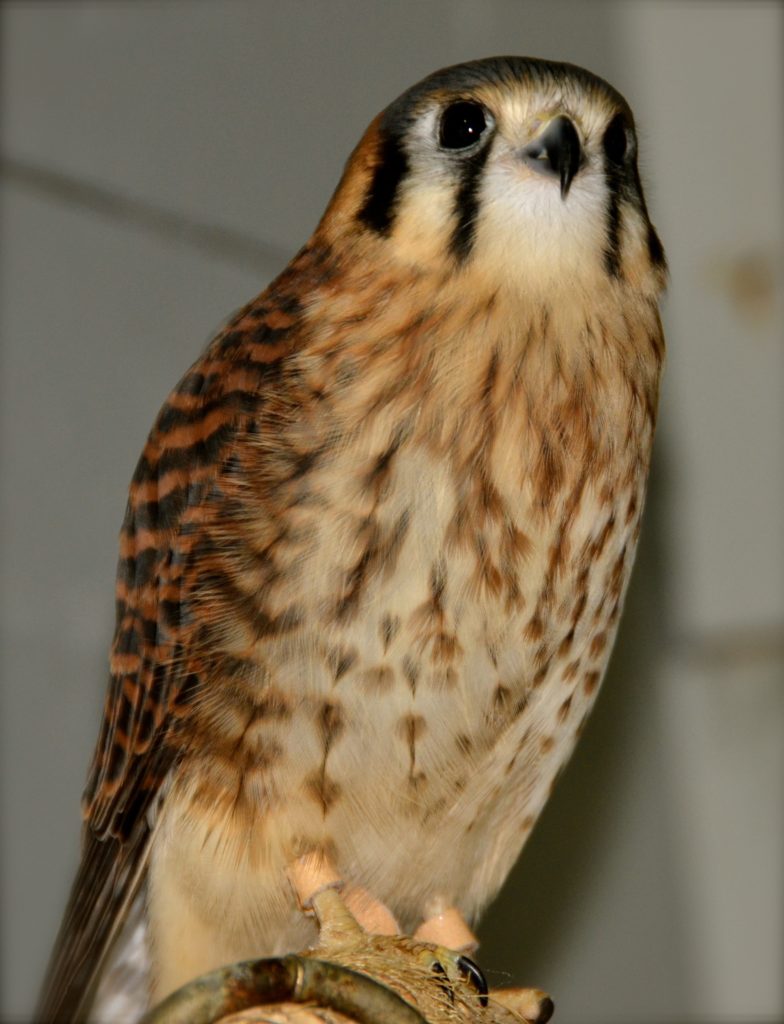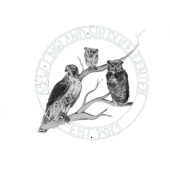
October is the month when we finally know it is Fall. Almost all of the center’s large mammals have been released; our small mammal babies are grown up enough to be on their own and find new homes, and our admission of birds of prey starts to rise. They are all hunting in earnest for their next rodent meal.
The red-tailed hawk featured here came to us with a fractured femur and rodenticide poisoning. Our veterinary staff was able to repair the fractured femur with surgery that included pins being put into the bones to hold them together. An external metal bar was then screwed to the outside of the leg.
This hawk is still in our care. The femur fracture should heal in about three weeks, at which time all the metal pieces will be removed. Due to their excess weight, they cannot be left in or the hawk would not be able to fly.
The next step in his recovery will be to build back his muscles and learn to fly silently. He will be moved from his enclosure in the clinic to an outdoor aviary flight cage. That takes care of the fracture, but what about the rodenticide poisoning?
Rodenticide poisoning happens when a person or animal ingests rat poison. Most rat poison is Warfarin, which works by disturbing the normal blood clotting process. It inhibits the Vitamin K enzyme that would normally activate Vitamin K into the system. Vitamin K is crucial for clotting. Once ingested the animal, or human, begins to bleed internally and hemorrhage. A very horrific way for anything to die.
Non-targeted wildlife species and pets are also often attracted to these baits when they are put outside. They are tasty and tempting. This includes chipmunks, squirrels, and even songbirds. Cockroaches and other invertebrates eat the bait placed in outdoor bait stations. The poison doesn’t hurt them, but they scatter the poisoned material and also store it in their bodies, which can lead to secondary poisoning of anything that eats it (small mammals, birds). This secondary poisoning is also what affects birds of prey.
Once you put rat poison out in your home or yard to kill the rodents that begin to flock into our homes in the Fall, it takes several days for those animals that have ingested the bait to die. In the interim, they go about their business of running around outside and often end up as food for birds of prey (owls, hawks). Rodents are their primary food source. They eat the poisoned rat and then get secondary rodenticide poisoning. This is probably what happened to our red-tailed hawk featured here. Mammalian predators like foxes and fishers also get poisoned this way. It is difficult to find birds of prey that do not carry some of this poisoning in their system.
Poisoned animals show signs such as difficulty breathing, internal bleeding, lethargy, and depression. Once this happens to wildlife, they can’t hunt effectively or move as fast. Before they bleed out and die, they risk being eaten by another predator (thus spreading the poison further), or being easily injured or hit by a car. We believe our featured red-tailed hawk fell ill from the rodenticide and then got hit by car, causing the severe femur fracture.
Can rodenticide poisoning be treated? Yes, it can, especially if it is caught early. At Cape Wildlife Center, we draw blood and test the clotting times of animals suspected of being poisoned. If the blood is slow to clot or not clotting, we them give large doses of Vitamin K. We repeat this process over many weeks or months until the blood is clotting normally. Our hawk will be in treatment longer for its rodenticide poisoning than for a femur fracture.
There is also a relatively new rodenticide, Bromethalin, that acts differently. It is even worse. It is a neurotoxin that causes paralysis and coma, and can kill within 15 minutes. If your pet or child or non-targeted wildlife ingests this, there is greater risk of fatality.
Rodents are a problem, particularly on Cape Cod. The best environmentally safe method to rid your home of them is to seal up all the cracks and holes in your foundation and around pipes. Remove debris and garbage from your yard and don’t leave food around in your house. Don’t feed wildlife or pets outside. Your goal is to block their entries and eliminate any food. They will move elsewhere.
If you must do something else, you can try peppermint oil placed around your home. Snap traps are another option. They will not cause any secondary fatalities, but there is still the chance non-targeted species (squirrels, bunnies birds) will get caught and killed. Do not use glue traps; they are completely inhumane and should be banned. Do not use Hav-a-Hart traps. Once trapped, the animals cannot be released legally anywhere except back on your property. Putting up owl boxes on your property is a way of letting nature handle the pest problem.
With the rodent increase in the colder weather, we see an increase in secondary rodenticide poisoning and an increase in admissions. This featured red tailed hawk was one of the 300 wildlife admissions we had in September. We have had 34 successful releases and many still remain in our care.
To learn more about the Cape Wildlife Center or help in its mission, visit www.capewildlifecenter.com or call 362-0111.
Caryn Ritchie is the volunteer coordinator for the Cape Wildlife Center and holds both a Massachusetts wildlife rehabilitator’s license and a federal permit to rehabilitate migratory birds.

Recent Comments